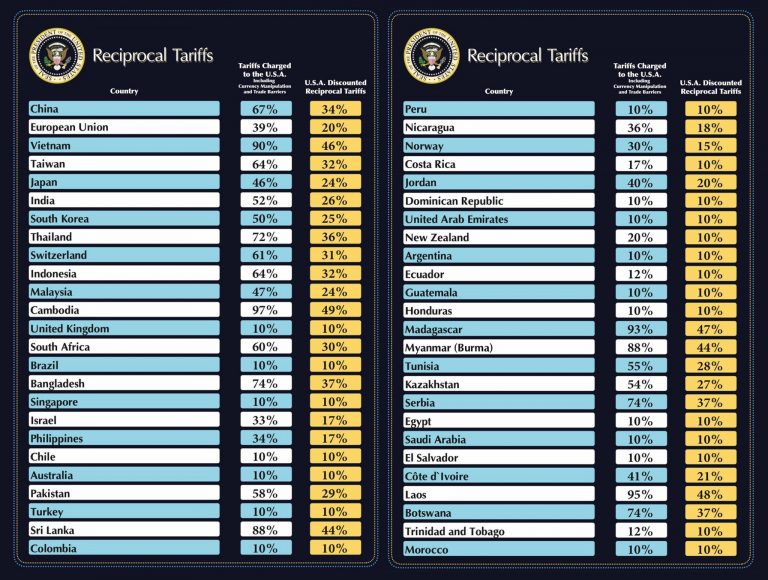
President Donald Trump shared an eight-point “non-tariff cheating” list on Truth Social, targeting trade practices he claims harm U.S. interests. Posted on Easter Sunday, the list highlights methods allegedly used by trading partners to gain unfair advantages, potentially straining diplomatic and trade relations. This move followed his April 9 announcement of a 90-day pause on sweeping reciprocal tariffs for most countries, except China, amid negotiations with over 75 nations. The list includes:
Accusing countries of devaluing currencies to boost exports and make U.S. goods costlier abroad. Claiming VATs act as tariffs by taxing imports while refunding exports, creating an uneven playing field. Selling goods abroad at prices lower than domestic markets or production costs. Providing financial support to exporters, distorting market competition.
Citing examples like the EU’s ban on genetically engineered corn as barriers to U.S. exports. Referencing Japan’s alleged “bowling ball test” to block U.S. cars, a claim Trump made in 2018. Intellectual property violations that harm U.S. businesses. Routing goods through third countries to evade U.S. tariffs.
Register for Tekedia Mini-MBA edition 19 (Feb 9 – May 2, 2026): big discounts for early bird.
Tekedia AI in Business Masterclass opens registrations.
Join Tekedia Capital Syndicate and co-invest in great global startups.
Register for Tekedia AI Lab: From Technical Design to Deployment (next edition begins Jan 24 2026).
Trump’s list aligns with his broader trade agenda, emphasizing reciprocity and reducing the U.S. goods trade deficit, which he declared a national emergency on April 2, 2025, under the International Emergency Economic Powers Act. He argues these non-tariff barriers are as damaging as tariffs, if not worse, and aims to pressure trading partners to negotiate fairer terms. The announcement coincided with heightened U.S.-China trade tensions, with tariffs on Chinese goods escalating to 145% after Beijing’s retaliatory 125% duties.
The list sparked market reactions, with gold prices surging 3.5% per ounce within an hour, reflecting demand for safe-haven assets. Bitcoin and Ethereum rose 2.2% and 1.8%, respectively, while gold-backed cryptocurrencies like Tether Gold saw a 25% trading volume spike. Critics, including economists like Kent Jones, argue Trump’s focus on trade deficits oversimplifies imbalances, which often stem from comparative advantages rather than “cheating.”
Some note the U.S. also employs non-tariff barriers, like quotas, complicating the narrative. The World Trade Organization can adjudicate genuine trade violations, but Trump’s formula—based on trade deficits rather than evidence of cheating—has drawn skepticism for lacking economic validity.
Trump’s administration imposed tariffs starting with a 10% levy on Chinese goods on February 1, 2025, escalating to 20% by March 4, 54% by April 2, and reaching 145% by April 9, following China’s retaliatory tariffs of up to 125%. These tit-for-tat measures have led to a near-total freeze in bilateral goods trade, with the World Trade Organization (WTO) estimating an 80% drop in U.S.-China merchandise trade in 2025.
Trump’s “non-tariff cheating” list, posted on April 20, 2025, accuses China of practices like currency manipulation, export subsidies, and intellectual property theft. This aligns with his broader narrative of addressing trade imbalances, though critics argue it oversimplifies economic dynamics. China counters that U.S. tariffs infringe on its sovereignty and demands structural economic changes. The tariffs are projected to cost U.S. households an average of $1,243 annually and reduce after-tax income by 1.2%. Imports are expected to fall by $800 billion (23%) in 2025, with global trade declining by 1.5% and GDP growth slowing to 2.2%.
China’s economy, already facing a slowdown, is shifting toward domestic demand and diversified export markets, reducing reliance on the U.S. from 19.8% of exports in 2018 to 12.8% in 2023. Trump’s strategy aims to isolate China by negotiating tariff deals with other nations, but Beijing is countering with diplomatic outreach, forging trade ties with Vietnam, Malaysia, and others. China’s leaders believe their economy is resilient enough to endure prolonged trade disruptions, while Trump’s approach risks alienating allies like Japan and South Korea, who face high U.S. tariffs.
The trade war threatens to split the global trading system into U.S.- and China-led blocs, with Southeast Asian nations hedging toward China. Tensions also risk spilling into military and diplomatic arenas, particularly over issues like Taiwan and critical minerals, where China has restricted exports to the U.S. Both sides show little willingness to de-escalate. Trump insists on Xi Jinping initiating talks, while China vows to “fight to the end,” leveraging its economic resilience and global partnerships. The standoff is causing market volatility, with U.S. businesses facing supply chain disruptions and higher costs.



